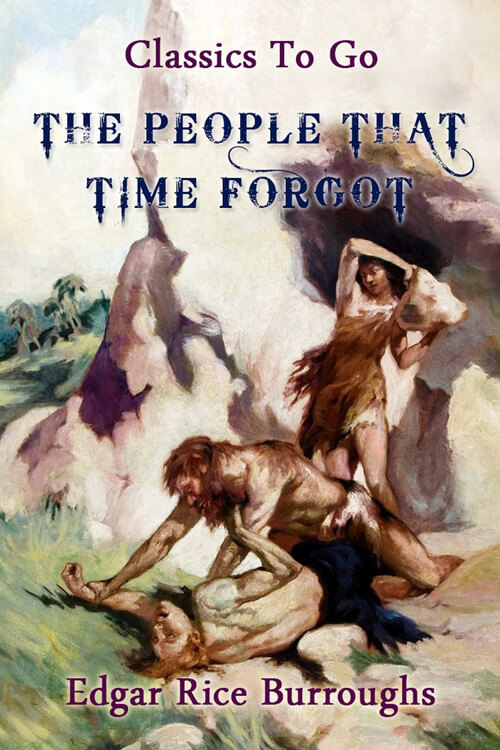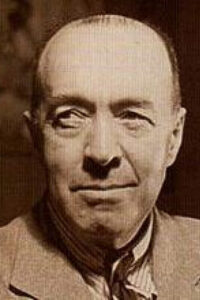
The People that Time Forgot
I am forced to admit that even though I had traveled a long distance to place Bowen Tyler’s manuscript in the hands of his father, I was still a trifle skeptical as to its sincerity since I could not but recall that it had not been many years since Bowen had been one of the most notorious practical jokers of his alma mater. The truth was that as I sat in the Tyler library at Santa Monica, I began to feel a little foolish and wish that I had merely forwarded the manuscript by express instead of bearing it personally, for I confess that I do not enjoy being laughed at. I have a well-developed sense of humor—when the joke is not on me.
Mr. Tyler, Sr., was expected almost hourly. The last steamer from Honolulu had brought information on the date of the expected sailing of his yacht, Toreador, which was now twenty-four hours overdue. Mr. Tyler’s assistant secretary, who had been left at home, assured me that there was no doubt but that the Toreador had sailed as promised since he knew his employer well enough to be optimistic that nothing short of an act of God would prevent his doing what he had planned to do. I was also aware that the sending apparatus of the Toreador’s wireless equipment was sealed and that it would only be used in the event of dire necessity.
There was, therefore, nothing to do but wait, and we waited.
We discussed the manuscript, hazarded guesses, and the strange events it narrated. The torpedoing of the liner upon which Bowen J. Tyler, Jr., had taken passage for France to join the American Ambulance was a well-known fact, and I had further substantiated by wire to the New York office of the owners that Miss La Rue had been booked for passage. Further, neither she nor Bowen had been mentioned among the list of survivors, nor had the bodies of either of them been recovered.
Their rescue by the English tug was entirely probable; the capture of the enemy U-33 by the tug’s crew was not beyond the range of possibility; and their adventures during the perilous cruise, which the treachery and deceit of Benson extended until they found themselves in the waters of the far South Pacific with depleted stores and poisoned water-casks, while bordering upon the fantastic, appeared logical enough as narrated, event by event, in the manuscript.
Read or download Book
Edgar Rice Burroughs
Edgar Rice Burroughs (September 1, 1875 – March 19, 1950) was an American writer best known for prolific output in adventure, science fiction, and fantasy. Best known for creating the characters Tarzan and John Carter, he also wrote the Pellucidar series, the Amtor series, and the Caspak trilogy. Tarzan was immediately famous, and Burroughs capitalized on it in every possible way, including a syndicated comic strip, films, and merchandise. Tarzan remains one of the most successful fictional characters today and is a cultural icon. Burroughs’s California ranch is now the center of the Tarzana neighborhood in Los Angeles, named after the character. Burroughs explicitly supported eugenics and scientific racism in both his fiction and nonfiction; Tarzan was meant to reflect these concepts.
Biography
Burroughs was born on September 1, 1875, in Chicago (he later lived for many years in the suburb of Oak Park), the fourth son of Major George Tyler Burroughs, a businessman and Civil War veteran, and his wife, Mary Evaline (Zieger) Burroughs. His middle name is from his paternal grandmother, Mary Coleman Rice Burroughs. Burroughs was almost entirely of English ancestry, with a family line in North America since the Colonial era. Through his Rice grandmother, Burroughs was descended from settler Edmund Rice, one of the English Puritans who moved to Massachusetts Bay Colony in the early 17th century. He remarked, “I can trace my ancestry back to Deacon Edmund Rice.”
The Burroughs side of the family was also of English origin, having emigrated to Massachusetts around the same time. Many of his ancestors fought in the American Revolution. Some of his ancestors settled in Virginia during the colonial period, and Burroughs often emphasized his connection with that side of his family, seeing it as romantic and warlike. Burroughs was educated at several local schools. He then attended Phillips Academy in Andover, Massachusetts, and the Michigan Military Academy. After graduating in 1895 but failing the United States Military Academy entrance exam at West Point, he became an enlisted soldier with the 7th U.S. Cavalry in Fort Grant, Arizona Territory. After being diagnosed with a heart problem and thus ineligible to serve, he was discharged in 1897.
After his discharge, Burroughs worked at several different jobs. During the Chicago influenza epidemic of 1891, he spent half a year at his brother’s ranch on the Raft River in Idaho as a cowboy, drifted somewhat afterward, then worked at his father’s Chicago battery factory in 1899, marrying his childhood sweetheart Emma Hulbert (1876–1944), in January 1900. In 1903, Burroughs joined his brothers, Yale graduates George and Harry, who were, by then, prominent Pocatello area ranchers in southern Idaho, and partners in the Sweetser-Burroughs Mining Company, where he took on managing their ill-fated Snake River gold dredge, a classic bucket-line dredge. The Burroughs brothers were also the sixth cousins, once removed, of famed miner Kate Rice, who, in 1914, became the first female prospector in the Canadian North. Journalist and publisher C. Allen Thorndike Rice was also his third cousin. When the new mine proved unsuccessful, the brothers secured Burroughs a position with the Oregon Short Line Railroad in Salt Lake City. Burroughs resigned from the railroad in October 1904.
Later life
By 1911, around age 36, Burroughs began to write fiction after seven years of low wages as a pencil-sharpener wholesaler. By this time, Emma and he had two children, Joan (1908–1972) and Hulbert (1909–1991). He had copious spare time during this period and began reading pulp fiction magazines. In 1929, he recalled thinking that:
“[…] If people were paid for writing rot, such as I read in some of those magazines, I could write stories just as rotten. Although I had never written a story, I knew I could write stories just as entertaining and probably much more so than any I chanced to read in those magazines.”
In 1913, Burroughs and Emma had their third and last child, John Coleman Burroughs (1913–1979), later known for his illustrations of his father’s books. In the 1920s, Burroughs became a pilot, purchased a Security Airster S-1, and encouraged his family to learn to fly. Daughter Joan married Tarzan film actor James Pierce. She starred with her husband as Jane’s voice from 1932 to 1934 for the Tarzan radio series. Burroughs divorced Emma in 1934, and, in 1935, married the former actress Florence Gilbert Dearholt, who was the former wife of his friend (who was then himself remarrying), Ashton Dearholt, with whom he had co-founded Burroughs-Tarzan Enterprises while filming The New Adventures of Tarzan. Burroughs adopted the Dearholts’ two children. He and Florence divorced in 1942.
Burroughs was in his late 60s and was in Honolulu at the time of the Japanese attack on Pearl Harbor. Despite his age, he applied for and received permission to become a war correspondent, becoming one of the oldest U.S. war correspondents during World War II. William Brinkley’s bestselling novel Don’t Go Near the Water mentions this period of his life.






